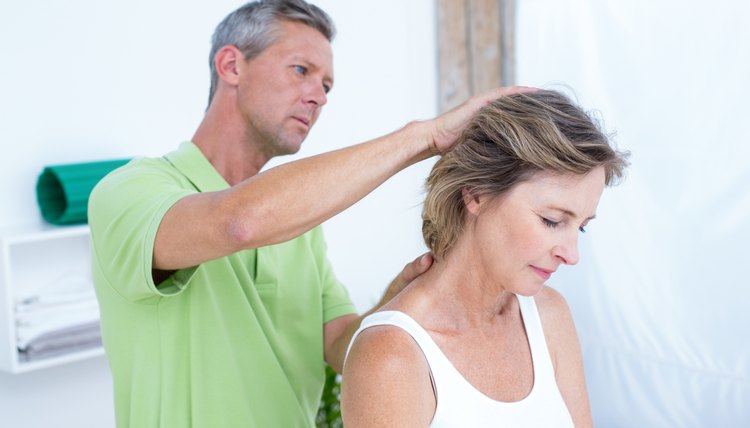Exercises for the Occipital Muscles

The occipital muscles are a group of muscles that are named because of their attachment to the base of the skull, the occipital bone. The larger, superficial muscles function to bend the neck backward, while the smaller, deeper muscles stabilize the skull on the spine against gravitational forces. The weight of the skull is not evenly distributed over the spine, and thus, it naturally falls forward. The occipital muscles keep the head in its proper, up-right position.
Stretching
When the occipital muscles are overworked, they tighten. Stretching allows the muscles to relax and reduces the tension. To stretch, stand with your back and head against a wall. Make sure your shoulder blades, buttocks and calves are touching the wall. Slowly tuck your chin down, toward your chest. Hold for 30 seconds and repeat three to five times per day.
Endurance and Strengthening
Because the occipital muscles are continually engaged throughout the day, they require endurance and strength to function properly. To train the occipital muscles, lie on a table, on your back. Begin with the back of your head against the table. Slowly press the back of the head into the table, creating a double chin. Complete eight to 12 repetitions, one to three times per day. To progress the exercise, perform the same movement standing against a wall.
Control
Exercises with minimal weight focus on training control and precision, rather than strength. To begin, lie on a table, on your back. While keeping the back of your head pinned to the table, slowly tuck your chin forward. The weight of the skull is enough to elicit resistance. Return your head to the starting position. Repeat eight to 12 times, three times per day.
Muscle Balance
Combination exercises train the flexor and extensor muscles of the skull to work together, thereby stabilizing the head and relieving undo strain on the occipital muscles. Begin by lying on a table, on your back. Rest your head against the table. Slightly bend your head forward, keeping the back of your head on the table and creating a double chin. Lift the head off the table to fully bend the head forward, keeping the chin tucked to your chest. Finally, place the head back on the table and press down, into the table. Complete eight to 12 cycles, three times per day.
References
- Anatomy of the Moving Body; Theodore Dimon, Jr.
- The Body in Motion; Theodore Dimon, Jr.
- Travell and Simon's Myofacial Pain and Dysfunction; David Simons, et al.
- Tension-Type and Cervicogenic Headache; Cesar Fernandez De las Penas, et al.
- Trail Guide to the Body; Andrew Biel
Resources
- Exercise Therapy; Fiona Wilson-O'Toole, et al.
Writer Bio
Erika McAuley is a freelance writer from Abbotsford, British Columbia. As an exercise rehabilitation professional, she has been preventing and treating musculoskeletal injuries in athletes and civil workers since 2008. McAuley holds a Bachelor of Human Kinetics in athletic therapy from Trinity Western University and an Advanced Certificate in Athletic Therapy from Mount Royal University.
